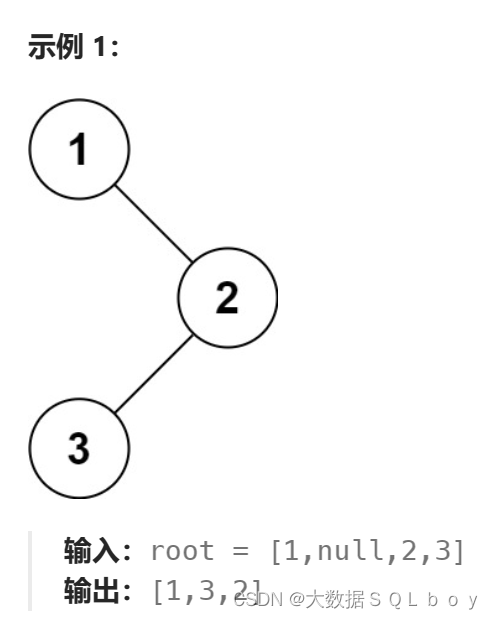二叉树的中序遍历,力扣
发布时间:2023年12月30日
目录
题目地址:
难度:简单
今天刷二叉树的中序遍历,大家有兴趣可以点上看看题目要求,试着做一下。
题目:
给定一个二叉树的根节点?root?,返回?它的?中序?遍历?。

我们直接看题解吧:
解题方法:
方法1,递归
方法2,迭代
方法3,Morris(空间复杂度(1))
解题分析:
中序遍历顺序:左子树->根节点->右子树(即左根右)
递归方法通俗易懂,但效率低,迭代方法,效率虽高,但不易理解,
因此这里着重讲一下Morris方法。
解题思路:
设当前遍历节点为x:
1、若x无左孩子,将x的值放入答案数组,接着访问x右孩子,即x=x.right。
2、若x有左孩子,则找到该左子树中最右的节点(即左子树中序遍历的最后一个节点)记为predecessor。
? ? · 若predecessor的右孩子为空,则将右孩子指向x,接着访问x左孩子即x=x.left
? ? ?·若predecessor的右孩子不为空,则将右孩子指向x,此时说明已遍历完x的左子树,则将predecessor的右孩子置空,将x的值加入答案数组,然后访问x的右孩子即x=x.right
3、重复上述操作,直至访问完整棵树。
?具体可结合题解-->??:94. 二叉树的中序遍历 题解
代码实现:
class Solution {
public List<Integer> inorderTraversal(TreeNode root) {
List<Integer> res = new ArrayList<Integer>(); //创建集合存储节点的值
TreeNode predecessor = null; //创建predxessor节点,并置空
while (root != null) {
if (root.left != null) {//左孩子不为空
// predecessor 节点就是当前 root 节点向左走一步,然后一直向右走至无法走为止
predecessor = root.left;
while (predecessor.right != null && predecessor.right != root) {
predecessor = predecessor.right;
}
// 让 predecessor 的右指针指向 root,继续遍历左子树
if (predecessor.right == null) {
predecessor.right = root;
root = root.left;
}
// 说明左子树已经访问完了,我们需要断开链接
else {
res.add(root.val);
predecessor.right = null;
root = root.right;
}
}
// 如果没有左孩子,则直接访问右孩子
else {
res.add(root.val);
root = root.right;
}
}
return res;
}
}
注:
其实整个过程我们就多做一步:假设当前遍历到的节点为 x,将 x?的左子树中最右边的节点的右孩子指向 x,这样在左子树遍历完成后我们通过这个指向走回了 x,且能通过这个指向知晓我们已经遍历完成了左子树,而不用再通过栈来维护,省去了栈的空间复杂度。
代码实现(递归):
class Solution {
public List<Integer> inorderTraversal(TreeNode root) {
List<Integer> res = new ArrayList<Integer>();
inorder(root, res);
return res;
}
public void inorder(TreeNode root, List<Integer> res) {
if (root == null) {
return;
}
inorder(root.left, res);
res.add(root.val);
inorder(root.right, res);
}
}
代码实现(迭代):
class Solution {
public List<Integer> inorderTraversal(TreeNode root) {
List<Integer> res = new ArrayList<Integer>();
Deque<TreeNode> stk = new LinkedList<TreeNode>();
while (root != null || !stk.isEmpty()) {
while (root != null) {
stk.push(root);
root = root.left;
}
root = stk.pop();
res.add(root.val);
root = root.right;
}
return res;
}
}
文章来源:https://blog.csdn.net/m0_70437378/article/details/135302791
本文来自互联网用户投稿,该文观点仅代表作者本人,不代表本站立场。本站仅提供信息存储空间服务,不拥有所有权,不承担相关法律责任。 如若内容造成侵权/违法违规/事实不符,请联系我的编程经验分享网邮箱:chenni525@qq.com进行投诉反馈,一经查实,立即删除!
本文来自互联网用户投稿,该文观点仅代表作者本人,不代表本站立场。本站仅提供信息存储空间服务,不拥有所有权,不承担相关法律责任。 如若内容造成侵权/违法违规/事实不符,请联系我的编程经验分享网邮箱:chenni525@qq.com进行投诉反馈,一经查实,立即删除!
最新文章
